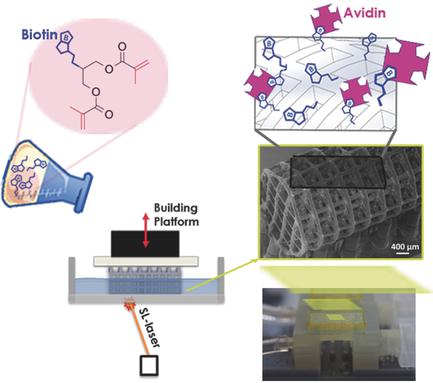Our official English website, www.x-mol.net, welcomes your feedback! (Note: you will need to create a separate account there.)
Biotinylated Photopolymers for 3D‐Printed Unibody Lab‐on‐a‐Chip Optical Platforms
Small ( IF 13.3 ) Pub Date : 2017-11-15 , DOI: 10.1002/smll.201702831 Caterina Credi 1 , Gianmarco Griffini 1 , Marinella Levi 1 , Stefano Turri 1
Small ( IF 13.3 ) Pub Date : 2017-11-15 , DOI: 10.1002/smll.201702831 Caterina Credi 1 , Gianmarco Griffini 1 , Marinella Levi 1 , Stefano Turri 1
Affiliation

|
The present work reports the first demonstration of straightforward fabrication of monolithic unibody lab‐on‐a‐chip (ULOCs) integrating bioactive micrometric 3D scaffolds by means of multimaterial stereolithography (SL). To this end, a novel biotin‐conjugated photopolymer is successfully synthesized and optimally formulated to achieve high‐performance SL‐printing resolution, as demonstrated by the SL‐fabrication of biotinylated structures smaller than 100 µm. By optimizing a multimaterial single‐run SL‐based 3D‐printing process, such biotinylated microstructures are incorporated within perfusion microchambers whose excellent optical transparency enables real‐time optical microscopy analyses. Standard biotin‐binding assays confirm the existence of biotin‐heads on the surfaces of the embedded 3D microstructures and allow to demonstrate that the biofunctionality of biotin is not altered during the SL‐printing, thus making it exploitable for further conjugation with other biomolecules. As a step forward, an in‐line optical detection system is designed, prototyped via SL‐printing and serially connected to the perfusion microchambers through customized world‐to‐chip connectors. Such detection system is successfully employed to optically analyze the solution flowing out of the microchambers, thus enabling indirect quantification of the concentration of target interacting biomolecules. The successful application of this novel biofunctional photopolymer as SL‐material enables to greatly extend the versatility of SL to directly fabricate ULOCs with intrinsic biofunctionality.
中文翻译:

用于3D打印Unibody芯片实验室光学平台的生物素化光敏聚合物
本工作报告了通过多材料立体光刻技术(SL)直接制造集成了生物活性测微3D支架的整体式单体实验室(ULOC)的首次演示。为此,成功合成了一种新型的生物素共轭光敏聚合物,并对其进行了优化配制,以实现高性能的SL印刷分辨率,这是通过小于100 µm的生物素化结构的SL制备证明的。通过优化基于SL的多材料单次运行3D打印过程,将这种生物素化的微结构整合到灌注微腔室内,其出色的光学透明性可实现实时光学显微镜分析。标准的生物素结合测定法可确认嵌入式3D微结构表面上存在生物素头,并可以证明生物素的生物功能在SL印刷过程中没有改变,从而使其可与其他生物分子进一步结合。作为前进的一步,设计了一种在线光学检测系统,该系统通过SL印刷进行原型设计,并通过定制的世界芯片连接器串行连接到灌注微室。这种检测系统已成功用于光学分析流出微腔室的溶液,从而能够间接定量分析目标相互作用生物分子的浓度。
更新日期:2017-11-15
中文翻译:

用于3D打印Unibody芯片实验室光学平台的生物素化光敏聚合物
本工作报告了通过多材料立体光刻技术(SL)直接制造集成了生物活性测微3D支架的整体式单体实验室(ULOC)的首次演示。为此,成功合成了一种新型的生物素共轭光敏聚合物,并对其进行了优化配制,以实现高性能的SL印刷分辨率,这是通过小于100 µm的生物素化结构的SL制备证明的。通过优化基于SL的多材料单次运行3D打印过程,将这种生物素化的微结构整合到灌注微腔室内,其出色的光学透明性可实现实时光学显微镜分析。标准的生物素结合测定法可确认嵌入式3D微结构表面上存在生物素头,并可以证明生物素的生物功能在SL印刷过程中没有改变,从而使其可与其他生物分子进一步结合。作为前进的一步,设计了一种在线光学检测系统,该系统通过SL印刷进行原型设计,并通过定制的世界芯片连接器串行连接到灌注微室。这种检测系统已成功用于光学分析流出微腔室的溶液,从而能够间接定量分析目标相互作用生物分子的浓度。


























 京公网安备 11010802027423号
京公网安备 11010802027423号